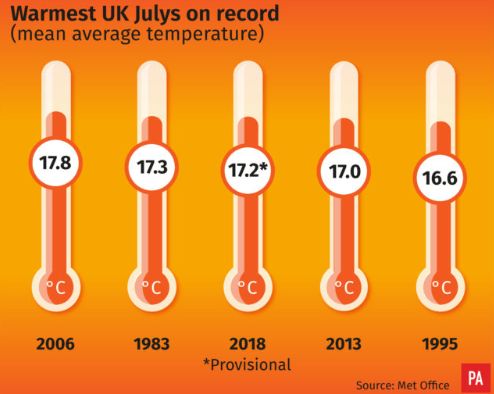
While the heatwave is set to return to the UK this week, with the mercury expected to reach 31C on Friday, temperatures in Spain and Portugal could hit a blistering 48C.
The Met Office on Wednesday warned holidaymakers heading for Europe to take extra care in the sun as temperatures may break the all-time highest record.
Forecasters said the Iberian region of Spain and the Algarve, in Portugal, could be at its hottest in 41 years by Friday.
The current record for Europe is 48C recorded in Athens, Greece, in July 1977.
Forecasters warned a blast of high pressure from North Africa could see the record equalled or broken.
Sky News’ Isobel Lang said: “Spain’s record high is 47.3C and Portugal’s is 47.4C but these temperatures could well be beaten.
“South west France could see temperatures locally top 40C.
“And 48C is possible across inland parts of Portugal and valleys of southern Spain”.
The weather warning comes after at least 91 people were killed in wildfires in Greece earlier this month, including newlywed Irishman Brian O’Callaghan who was on his honeymoon with wife Zoe Holohan.
The UK will get progressively warmer this week, from a high of 26C today to 31C on Friday, continuing the heatwave that has seen 20 days of temperatures over 30C between June 25 and July 25.
Last Friday forecasters predicted that the UK might set a new highest-ever temperature – 38.5C – but the weather cooled, leading to much-needed downpours. The highest temperature measured anywhere during July was 35.3C, on 26 July at Faversham in Kent.
Last month was the third warmest July on record, according to provisional figures released on Wednesday.

The mean average temperature across the UK was 17.2C last month, behind the 2006 record of 17.8C and also 17.3C in 1983.
Cooler temperatures and widespread thunderstorms last week meant no nationwide records were broken, the Met Office said. Northern Ireland ended up with 99% of its average total rainfall for July, thanks to torrential downpours over the weekend.
Overall, Britain has seen its driest first half of summer since 1961 and on Wednesday, the National Farmers’ Union warned Environment Secretary Michael Gove of an “unprecedented” impact on food production and “tinderbox” conditions caused by the drought.
The dry spell was most prolonged in East Anglia and south-east England in July, where some places such as Heathrow and High Wycombe experienced 58 “dry days” in a row. The Met Office defines a “dry day” as one with less than 1.0mm of recorded rainfall.
Broom’s Barn, near Bury St Edmunds, endured 51 days of no rain whatsoever – the longest this summer.
Dr Mark McCarthy, manager of the Met Office National Climate Information Centre, said: “The UK experienced its hottest ever May this year, and its second hottest June. For a large part of July it looked as if we might see another record-breaking month, but lower temperatures in the north and west and the storms at the end of the month meant that was not the case.
“However, temperatures were well above average and rainfall much lower, particularly in parts of England, continuing the pattern of an unusually warm, dry summer overall.”
Anticipation of Europe’s top temperature record being broken comes after several record highs were set in the northern hemisphere in the last two months.
Castlederg in Northern Island reached 30.1C on June 29, while temperatures in Tbilisi, Georgia, and Yerevan, Armenia, rose to 40.5C and 42C in early July.
In the US on June 28 Denver, Colorado set an all-time high of 40.6C, the Washington Post reported, and Death Valley in California recorded the hottest July ever with average temperatures of 42.2C.
Scientists have said the heatwave gripping northern Europe was made twice as likely by climate change, and the UK faces a future of increasingly common episodes of extremely hot spells.
